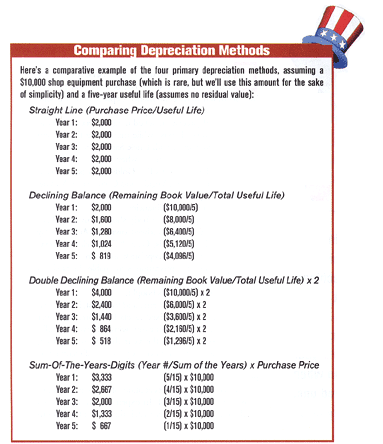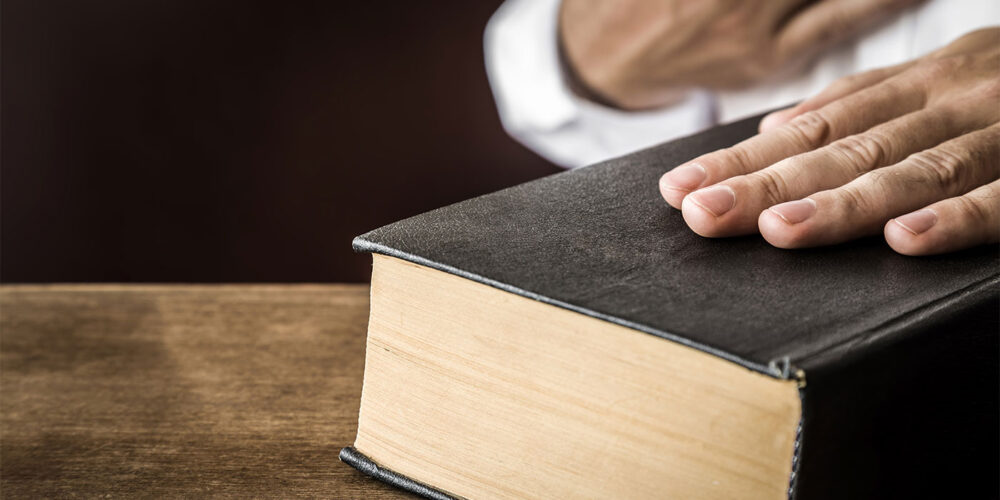Because of the capital intensive nature of running a body shop (i.e., because you have to buy so much darn equipment), depreciation is a vital component of any financial planning strategy. You need to optimize depreciation scheduling for your assets to keep your banker happy, while minimizing the amount of net profit you share with Uncle Sam every year.
“There are several [options] when it comes to depreciation of fixed assets,” says Phil Goldstein, a partner with the CPA firm Levitan, Yegidis and Goldstein in Middleton, N.Y. “Depreciation methodology is a useful tool in tax planning and getting financing.”
What can depreciate in a body shop? “Anything that’s moveable,” says Kevin Caldwell, owner of Autobody by Caldwell in Laguna Hills, Calif. “That includes everything you can think of except brick and mortar.”
The purpose of depreciation is to enable the business to expense an asset purchase over the useful life of the asset rather than when it’s bought.
Why is this necessary? First and foremost, it’s the law. The IRS requires that fixed assets be depreciated over their useful life. If businesses were allowed to fully expense fixed assets in the year they were acquired, many businesses would never pay a dime of income tax. I know that sounds great but, unfortunately, it’s not legal.
The second reason depreciation of assets is necessary is as a management tool. In expensing an asset as it’s used, you can more easily match the cost of the asset to its revenue generation. This is useful to you, as the business owner, and to your banker. If you fully expensed asset purchases every year and showed a corresponding loss, you’d have difficulty obtaining financing for any purpose.
Methods of Depreciation
The chart “Comparing Depreciation Methods” provides a tangible example of the different methods of depreciation available to body shops. As you can see, the different depreciation strategies produce substantially different results in terms of the impact on the income statement and the balance sheet value of the asset from year to year.
Here’s a brief description of each method:
- Straight-line – This is the simplest method of depreciation. The purchase price of the asset is divided by the useful life in terms of years. The resulting depreciation amount is taken each year over the useful life until it runs out. The depreciation amount doesn’t change from year to year.
- “CARSTAR facilities use the straight-line method over seven years to depreciate machinery and equipment,” says Dean Koelzer, controller for CARSTAR Automotive, Inc. “Straight-line is the most commonly used depreciation method. From business to business, some variation does occur with the length of time applied. We chose seven years because that’s the overall average life span for our equipment.”
- Declining balance – This is the least aggressive depreciation method. In each year, the book value of the asset is divided by the total useful life, so while the numerator gets smaller each year, the denominator stays the same. If the declining balance method is used for the entire useful life of the asset, there’s a “residual” book value remaining at the end.
- Double declining balance – This is a very aggressive depreciation method. In each year, the book value of the asset is divided by the total useful life and the result is multiplied by two. While the amount of depreciation changes each year, it’s heavily front-loaded in this method. Double declining balance is often used for assets that get a lot of use early in the useful life or that don’t hold their value well.
- Sum-of-the-year-digits – This also is a relatively aggressive method, resulting in front-loaded depreciation levels in the earlier years of an asset’s useful life. First, the aggregate number of years in the useful life are totaled (i.e. 5 + 4 + 3 + 2 + 1 = 15). This number serves as the denominator with the inverse number for the number of years serving as the numerator (i.e. the number five would be used in year one; four in year two, etc.). The resulting fraction is then multiplied by the purchase price of the asset. This is another effective method for assets that lose their value quickly.
- Modified accelerated cost recovery system – This is a depreciation method allowed by the IRS that uses double declining balance in the early years, followed by a switch to straight-line later. For example, with a five-year asset, the double declining balance method is used in years one through three, switching to straight-line in years four and five. It’s an aggressive method that reduces tax liability in the early years, while still allowing for full depreciation of the asset before the useful life runs out (i.e. no residual book value at the end of the useful life).
Goldstein says many body shop owners use two different methods – one for tax reporting and one for financial reporting. This is legal – and often advisable – as long as both IRS guidelines and generally accepted accounting principles are adhered to. The advantage is that it enables you to minimize your tax liability while reporting a higher net income on your compiled, reviewed or audited CPA-prepared financial statement. Talk with your accountant to see if your business qualifies for dual reporting for depreciation.
Which Method Is Best for Your Shop?
The declining balance and straight-line methods are the most conservative, so if your fixed assets tend to depreciate evenly over their useful life, then these methods should work well for you. The double declining balance, sum-of-the-years-digits and modified accelerated cost recovery system methods are the most aggressive and should work well if your shop assets lose their value quickly.
“Most assets don’t depreciate evenly over their useful life,” says Goldstein. “Assets tend to depreciate much quicker in year one and then less each year going forward.
“The way you can tell if your depreciation method is effective is when you’re selling the assets close to book value. If you depreciate assets too fast, you’ll show marginal profits for a few years and then one big profit year when you dispose of the assets. If you depreciate assets too slowly, you’ll show healthy profits for a few years and then a loss year when the assets are sold.”
Goldstein says you should try to show a steadily improving level of profitability each year. It makes tax planning easier and bankers will more likely look favorably on loan requests.
“You never know when you’ll need to borrow money,” says Goldstein. “Bankers want to see a strong balance sheet as well as consistent cash flow coverage sufficient to repay the company’s debts. Bankers don’t like inconsistent profits. And if you wind up needing to borrow money in a year you show a loss, you’re likely to be turned down.”
A few other pointers from Goldstein regarding depreciation methods:
- No asset can be depreciated below the salvage value.
- For body shops with total fixed asset purchases of less than $200,000 in a year, there’s an immediate deduction of $18,500 allowed.
- The maximum depreciation deductions for automobiles are $3,160 in year one; $5,000 in year two; $2,950 in year three; $1,775 in year four and thereafter.
- In depreciating assets, the three conventions to apply are half-year, mid-quarter and mid-month.
- Three items determine annual depreciation calculations: method of depreciation, asset life and convention.

Choose Wisely
It’s important for business owners to pay close attention to the method of depreciation used. It’s especially important for shop owners because of how much money is spent on equipment and other capital investments. Finding the right depreciation method will minimize the check you write to Uncle Sam each year and maximize your chances of getting a loan from your banker the next time you need financing.
BodyShop Business contributing editor J. Tol Broome Jr. is a financial expert who’s been in the lending business for more than 15 years.













